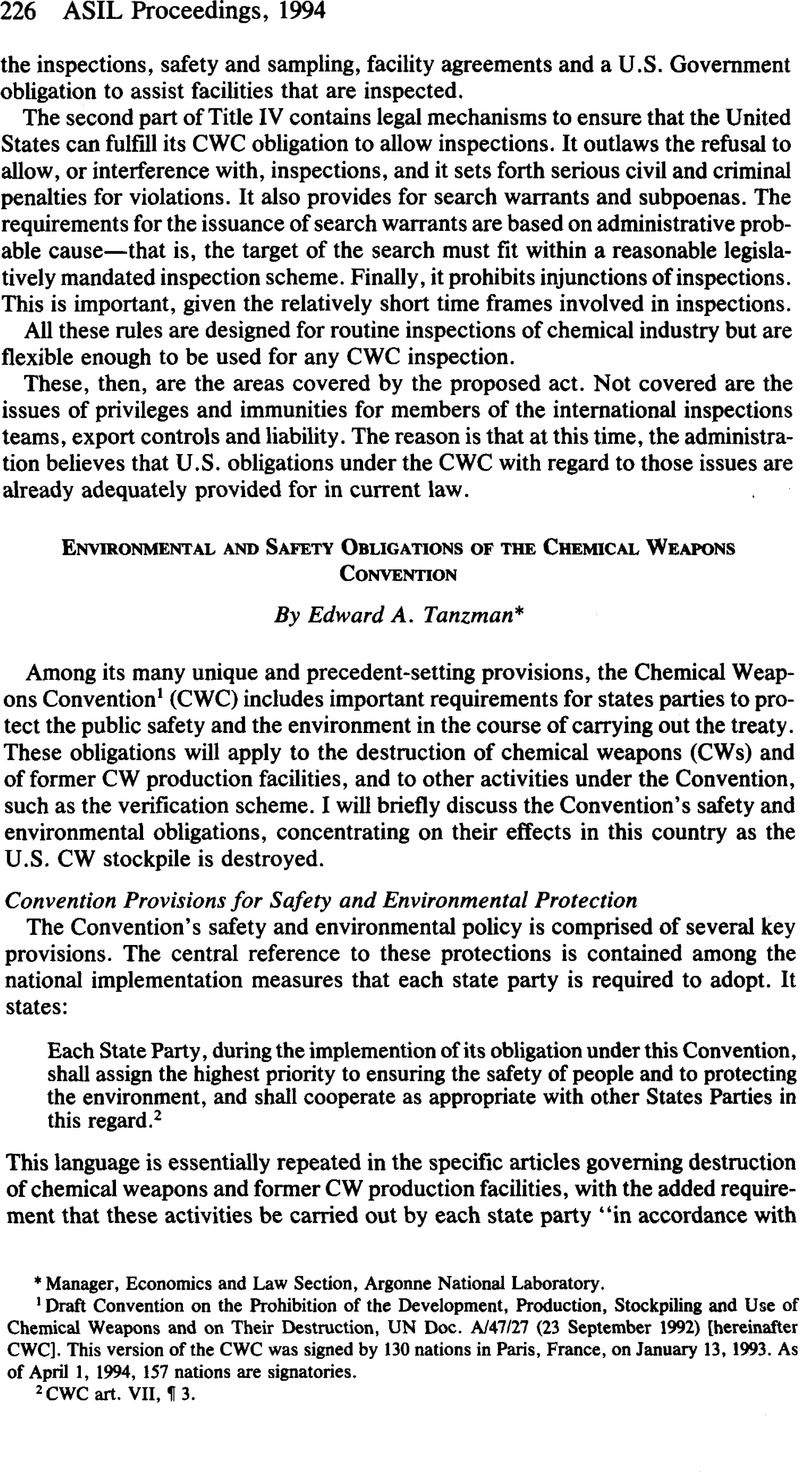No CrossRef data available.
Article contents
Environmental and Safety Obligations of the Chemical Weapons Convention
Published online by Cambridge University Press: 28 February 2017
Abstract

- Type
- Implementing the Chemical Weapons Convention: Progress and Challenges
- Information
- Copyright
- Copyright © American Society of International Law 1994
References
1 Draft Convention on the Prohibition of the Development, Production, Stockpiling and Use of Chemical Weapons and on Their Destruction, UN Doc. A/47/27 (23 September 1992) [hereinafter CWC]. This version of the CWC was signed by 130 nations in Paris, France, on January 13, 1993. As of April 1, 1994, 157 nations are signatories.
2 CWC art. VII, ¶ 3.
3 CWC art. IV, ¶ 10 states that “[e]ach State Party, during transportation, sampling, storage, and destruction of chemical weapons, shall assign the highest priority to ensuring the safety of people and to protecting the environment. Each State Party shall transport, sample, store and destroy chemical weapons in accordance with its national standards for safety and emissions.” Art. V, ¶ 11 imposes the same requirements on destroying CW production faculties.
4 CWC Verification Annex, Part IV (A), at 13. However, since this provision is located in an Annex to the Convention, where reservations are permitted, it would be possible for a state party to ratify the Convention while exempting itself from these restrictions (CWC art. XXII). Nevertheless, singling out these undesirable destruction methods and imposing on each state party the burden of specifically including a reservation in order to retain them as options can be expected to make it more politically difficult to use them. Furthermore, ¶ 32 obligates a state party to provide to the Technical Secretariat the safety plans and environmental permits that have been obtained for each of its CW destruction facilities.
5 See generally CWC art. VIII, note 1.
6 CWC arts. 1 & II.
7 CWC part IV(A), C(24)-(28).
8 Doty, Paul, The Challenge of Destroying Chemical Weapons , Arms Control Today, Oct. 1992, at 29Google Scholar.
9 See CWC, Annex on Verification and Implementation, part IV(B).
10 See generally President’s Message to Congress Transmitting the “Environmental Review of the Chemical Weapons Convention,” § 2.1, reprinted in CONG. REC. S2168 (daily ed., March 1, 1994).
11 Supra note 10, at 2.2.2.1
12 Defense Authorization Act of 1993, Pub. L. No. 102-484, 171, 106 Stat. 2315 (1993).
13 See Testimony on the Chemical Demilitarization Program, 103d Cong., IstSess. 19 (1993) (statement of M. Owen, Assistant Secretary of the Army (Installations, Logistics and Environment)).
14 Program Manager For Non-Stockpile Chemical Materiel, Non-Stockpile Chemical Materiel Program: Survey And Analysis Report, US Army Chemical Materiel Destruction Agency, at 9-1 (1993).
15 See President’s Message to Congress, supra note 10.
16 See, e.g., Costner, Patricia, Chemical Weapons Demilitarization and Disposal: Johnston Atoll Chemical Disposal System, GB and VX Campaigns 1 (presented at the Moscon ’93 conference, May 12, 1993)Google Scholar.
17 National Research Council Committee On Review And Evaluation Of The Army Chemical Stockpile Disposal Program, Et Al., Recommendations For The Disposal Of Chemical Agents And Munitions 121 (1994).
18 Supra note 12, at 26.
19 Supra note 14, at 4.2.1
20 Supra note 12, at 26.
21 See Gualtieri, David Et Al., Chemical Weapons Inspection Of Private Facilities� Application Of United States Environmental And Safety Laws 49-51 (Defense Nuclear Agency TR-9370, 1993)Google Scholar.
22 “Cooperation of executive and police officials of states and municipalities appears … clearly desirable and helpful. … There are certainly no obstacles under the laws of the United States to voluntary cooperation between states and municipalities and an international arms inspectorate.” Louis Henkin, Arms Control And Inspection In American Law 102 (1958).




